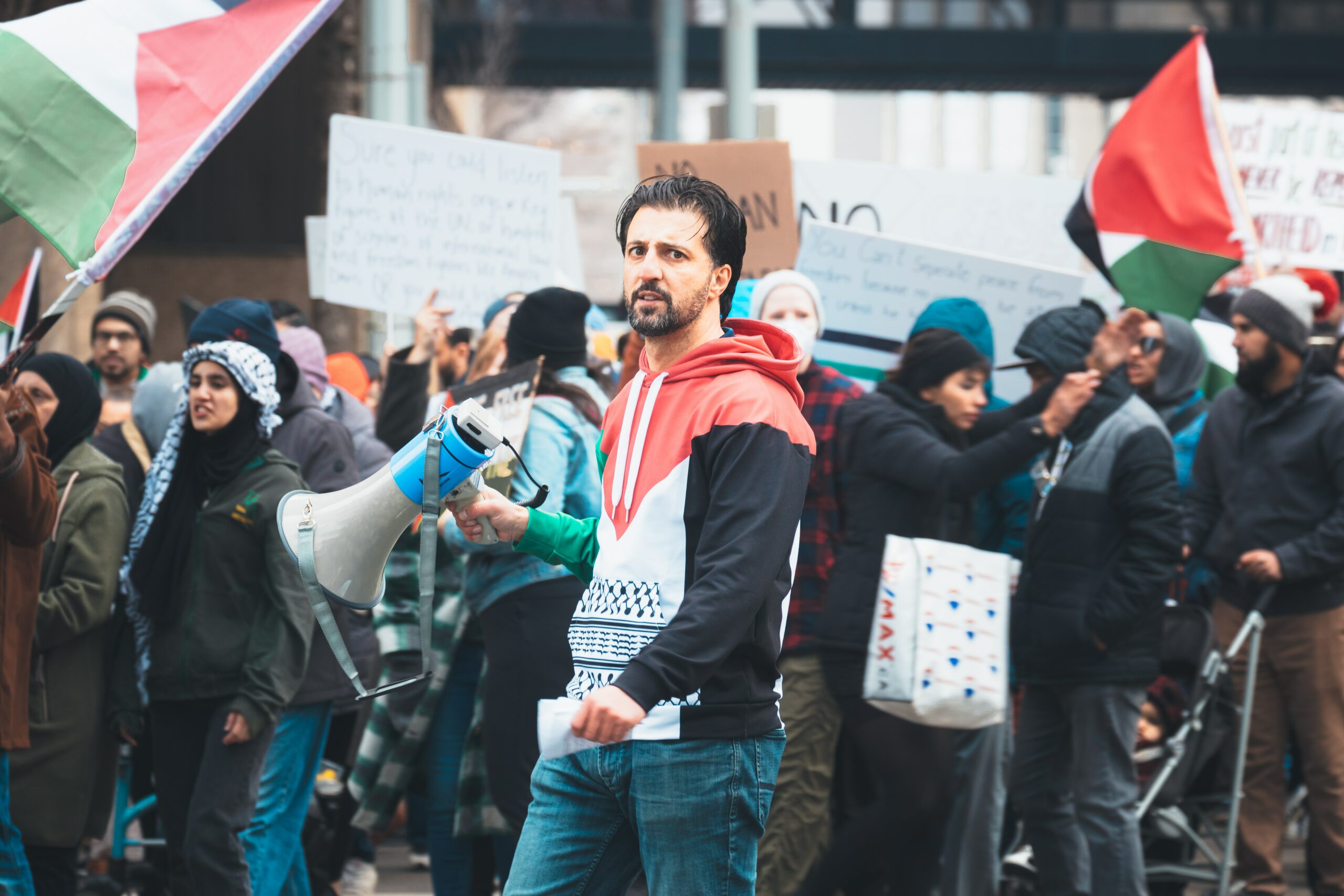The rebirth of a new Nakba
The number of displaced Palestinians doubled to almost two million after months of intense bombardment of the Gaza Strip.
In May 1948, armed Zionist forces declared the State of Israel, marking the first Arab-Israeli war. As a result, Palestinians experienced ethnic cleansing and mass displacement. By 1949, at least 750,000 Palestinians were expelled from their homes and became refugees of their land. As of January 1, 2024, the number has more than doubled to 1.9 million internally displaced Palestinians in Gaza—which is more than 85 per cent of the population.
Many are calling this a second Nakba.
The word “Nakba” was coined by Constantine Zurayk, a Syrian historian and intellectual who taught at the American University of Beirut. Nakba is an Arabic word that translates to “catastrophe.” It is also used to mark the mass displacement of Palestinians in 1948.
Zurayk analyzes the Nakba in his 1956 book, The Meaning of Disaster.
“A country is snatched from its people to be made into a national home for remnants of mankind who settle on it from the various regions of the world and who erect a state in it despite its inhabitants and the millions of their brethren in the neighboring regions.”
The statement Zurayk makes in his book references the events that triggered the Israeli occupation. In 1948, Zionist military forces captured 78 per cent of historic Palestine. Between 1947 and 1949, military forces targeted major Palestinian cities and destroyed roughly 530 villages. The remaining 22 per cent was divided into today’s occupied West Bank and the besieged Gaza Strip.
Before the Nakba
The Nakba stemmed from the emergence of Zionism as a political ideology in Eastern Europe. The ideology advocated the belief that Jews were a nation that deserved their own state after their persecution in Europe. After facing the 1882 anti-Semitic persecution in the Russian Empire, thousands of Eastern European and Russian Jews settled in Palestine.
While some advocated for a Jewish state in nations including Uganda and Argentina, they eventually decided on Palestine. Jews regarded territories around Jerusalem as the Holy Land. Thus, their decision to pursue Palestine was based on the biblical notion that the Holy Land, or Jerusalem, was promised to them by God.
In the 1930s, as Jewish immigration increased, the conflict between Arabs and Jews intensified. Following the 1940s persecution of Jews by the Nazis in Europe, the Zionist movement re-emerged to establish a Jewish state in Palestine.
In November 1947, before the Nakba, the United Nations (UN) General Assembly passed Resolution 181 partitioning Great Britain’s former Palestine into two states—one Jewish and one Arab—between the Mediterranean Sea and the Jordan River. This is also where the infamous Palestinian slogan, “From the river to the sea, Palestine will be free” originated.
The Arab population rejected the resolution and argued it was unfair. It violated the UN Charter and favoured the Jewish state. Almost half of the Palestinian population would have been converted overnight into a minority under Jewish rule had the resolution been enacted. The partition allocated 52 per cent of the land to the Jewish state and 45 per cent to the Arab state while Jerusalem was still under international control.
Thirty-three countries, including Canada, the US, France, and Norway voted in favour of the resolution. Thirteen countries, including Egypt, Iran, Iraq, Saudi Arabia, and Turkey voted against, and 10 including China, the UK, and Argentina abstained.
Between 1947 and 1949, Zionist military forces committed multiple massacres that killed more than 15,000 Palestinians—creating a refugee crisis that remains unresolved to this day.
Israel’s Massacres in Palestine During the 1948 War
On December 18, 1947, the Haganah Zionist military troops killed 10 Palestinians in the al-Khisas massacre, which included five children, and wounded five others. Haganah troops did not experience any casualties.
On December 31, 1947, the Baldat al-Sheikh massacre resulted in 70 Palestinians dead. On February 14, 1948, the Sa’sa’ massacre resulted in 60 Palestinians dead and 16 houses blown up. April 9, 1948, the Deir Yassin massacre resulted in 110 Palestinians dead, most of whom were women and children. On April 12 and 13, 1948, the Nasir al-Din massacre resulted in 50 Palestinians dead with houses destroyed and set on fire.
On April 22, 1948, the Haifa massacre killed 50 Palestinians and wounded 200 others. On May 22 and 23, 1948, a week after the declaration of the State of Israel, the al-Tantura Massacre killed more than 200 Tantura villagers, which comprised mostly unarmed young men who were shot.
These massacres occurred before the State of Israel was declared and established in May 1948. The killings signify the existence of Zionist military rule over historic Palestine before the displacement process began.
Thus, May 14, 1948, signifies two things: the establishment of the Israeli State and the birth of the Palestinian refugee crisis.
2023 Nakba
The refugee crisis persisted until today. Following the events of October 7, 2023, the conflict has intensified immensely into what many are calling a second Nakba.
As of January 2024, more than 22,000 Palestinians have been killed while at least 57,000 have been injured since October 7, 2023. According to Al Jazeera Media Network, the current death toll stands at 22,185 Palestinians since January 2—including more than 9,100 children and 6,500 women.
More than 7,000 Palestinians remain missing.
Due to Gaza’s collapsed health system, most of those who are injured are unable to receive the mere basics of medical attention. Thousands remain missing under rubble caused by constant Israeli air and artillery strikes. For months, Palestinians have continued to dig through tons of wreckage with shovels and bare hands, block after block while the smell of death looms in the air.
Today, almost two million Palestinians are displaced, numbers that have doubled since the 1948 Nakba.
Israeli security cabinet member and Agricultural Minister Avi Dichter declared on November 11, 2023, a second Nakba.
“Gaza Nakba 2023. That’s how it’ll end,” he stated.
In the news interview, Dichter publicly announced, “We are now rolling out the Gaza Nakba.”
The Israeli ethnic cleansing effort doesn’t stop in Gaza. It extends to the occupied West Bank. The year 2023 marks the deadliest year for Palestinians in the West Bank. The number of raids and attacks has skyrocketed since October 7, 2023, with at least 324 Palestinians, including 83 children, killed by Israeli forces. More than 3,800 remain injured.
More than one Palestinian child is killed per week, whereas at least six Israeli children have been killed throughout 2023.
Dichter’s threat to inflict a new Nakba is no longer a threat. It is already happening before our eyes and is resulting in the deaths and displacement of millions of Palestinians.
News Editor (Volume 48 & 50) — May is in her final year of undergraduate studies and is on her way to graduating with a double major in Criminology and Sociology. With more than 50 published articles, May has a wealth of experience writing for The Medium. May has also served as News Editor in Volume 48. She believes that news journalism is not just a privilege, but an important responsibility to report the unbiased truth.


